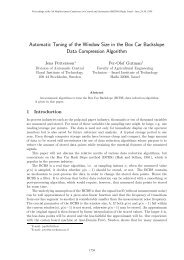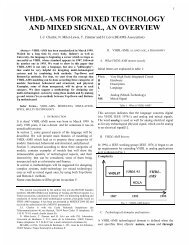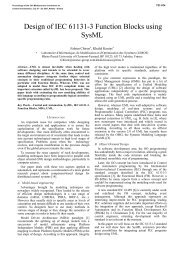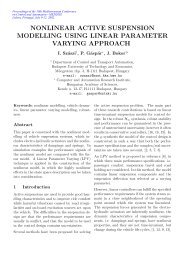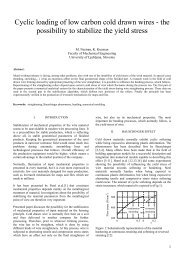Fourier Transform and Ludolph van Ceulen
Fourier Transform and Ludolph van Ceulen
Fourier Transform and Ludolph van Ceulen
You also want an ePaper? Increase the reach of your titles
YUMPU automatically turns print PDFs into web optimized ePapers that Google loves.
Abstract -- The author would like to dedicate this paper to the<br />
memory of <strong>Ludolph</strong> <strong>van</strong> <strong>Ceulen</strong> (1540-1610), the famous<br />
Dutch mathematician, who spent almost his whole life to<br />
calculate the first 35 decimals of !. Now, 400 years later, the<br />
known number of digits of ! exceeds 200 billion <strong>and</strong><br />
increasing. Highly efficient <strong>and</strong> very fast converging methods<br />
have been developed in the last decades. Without the number<br />
crunching power of digital computers it would never have<br />
been possible to calculate the billions of digits of !. Amazingly,<br />
the key element in calculating the billions of digits is an<br />
efficient multiplication method. And here we can find an<br />
unexpected application from signal processing <strong>and</strong> control<br />
theory: the Fast <strong>Fourier</strong> transform (FFT). The paper presents<br />
the most efficient algorithms <strong>and</strong> describes how the <strong>Fourier</strong><br />
transform makes fast multiplication possible.<br />
Index Terms -- <strong>Fourier</strong> transform, approximation theory,<br />
elliptic functions.<br />
O<br />
<strong>Fourier</strong> <strong>Transform</strong> <strong>and</strong> <strong>Ludolph</strong> <strong>van</strong> <strong>Ceulen</strong><br />
I. INTRODUCTION:<br />
n july 5, 2000 a very special ceremony 1 took place in<br />
the St.Pieterskerk (St.Peter's Church) at Leiden, the<br />
Netherl<strong>and</strong>s [16,18]. A replica of the original tombstone of<br />
<strong>Ludolph</strong> <strong>van</strong> <strong>Ceulen</strong> was placed into the Church since the<br />
original disappeared [17]. <strong>Ludolph</strong> <strong>van</strong> <strong>Ceulen</strong> (born 28<br />
January 1540 in Hildesheim <strong>and</strong> died 31 December 1610 in<br />
Leiden) was a mathematician <strong>and</strong> fencing teacher. In 1600<br />
Prince Maurits appointed him as one of the first hoogleraar<br />
wiskunde (professor of mathematics) at the University of<br />
Leiden. He dedicated almost all of his life to calculate more<br />
<strong>and</strong> more decimals of !. He published the 20 decimals in<br />
his book: Van de Circel in 1596. But he went on to<br />
calculate the first 35 decimals 2 . As legend has it, the 35<br />
decimals were engraved on his tombstone which later<br />
disappeared [11,16]. It was therefore a tribute to the<br />
memory of <strong>Ludolph</strong> <strong>van</strong> <strong>Ceulen</strong>, when on Wednesday 5<br />
july, 2000 prince Willem-Alex<strong>and</strong>er (heir to the throne),<br />
unveiled the memorial tombstone in the St.Peter's Church,<br />
in Leiden.<br />
1 The one day program "Pi in the St.Peter's Church" was part of the<br />
4th Algorithmic Number Theory Symposium (ANTS IV) in Leiden, The<br />
Netherl<strong>and</strong>s, 2-7 july, 2000.<br />
See also the home-page: http //www.wiskgenoot.nl<br />
2 It should be noted at this point that 39 decimals of ! suffice for<br />
computing the circumference of a circle enclosing the known universe<br />
with an error no greater than the radius of a hydrogen atom.<br />
M.Vajta, Member, IEEE<br />
Department of Mathematical Sciences<br />
University of Twente<br />
P.O.Box 217, 7500 AE Enschede<br />
The Netherl<strong>and</strong>s<br />
e-mail: m.vajta@math.utwente.nl<br />
Figure 1 shows the gedenksteen (memorial stone) in the<br />
St.Pieterskerk at Leiden [16]. Although the text is in old<br />
Dutch <strong>and</strong> difficult to decipher from the photo 3 , it can be<br />
observed that <strong>Ludolph</strong> <strong>van</strong> <strong>Ceulen</strong> gave two bounds for the<br />
value of !. He stated: if the diameter of a circle is 1, then<br />
the circumference is greater then<br />
14159265358979323846264338327950288<br />
3 10000000000000000000000000000000000<br />
<strong>and</strong> less then<br />
14159265358979323846264338327950289<br />
3 10000000000000000000000000000000000<br />
Consequently, the value of ! lies between these two<br />
values.<br />
A one day mini-Symposium accompanied the ceremony<br />
on the St.Peter's Church <strong>and</strong> several papers on <strong>Ludolph</strong> <strong>van</strong><br />
<strong>Ceulen</strong> also appeared in the Nieuw Archief voor Wiskunde<br />
Journal [10,11,16,17].<br />
Calculating more <strong>and</strong> more decimals of ! (first by h<strong>and</strong><br />
<strong>and</strong> then by digital computers) not only fascinated mathematicians<br />
from ancient times but kept them busy as well.<br />
They invented hundreds of methods but the known number<br />
of decimals remained only a couple of hundred as of the<br />
late 19 th century. All that changed with the advent of the<br />
digital computers. And although digital computers made<br />
possible to calculate thous<strong>and</strong>s of decimals, the underlying<br />
methods hardly changed <strong>and</strong> their convergence remained<br />
slow (linear). Until the 1970's. Then, in 1976, an innovative<br />
quadratic convergent formula (based on the method of<br />
algebraic-geometric mean) for the calculation of ! was<br />
published independently by Brent [12] <strong>and</strong> Salamin [19].<br />
Soon after Brent <strong>and</strong> Salamin the Borwein brothers<br />
developed cubically <strong>and</strong> quartically convergent algorithms<br />
[8,9].<br />
In spite of the incredible fast convergence of these<br />
algorithms, it was the application of the Fast <strong>Fourier</strong><br />
transform (for multiplication) which enhanced their<br />
efficiency <strong>and</strong> reduced computer time [2,12,15].<br />
3 The exact text can be found on the home-page of the Wiskundig<br />
Genootschap: http //www.wiskgenoot.nl <strong>and</strong> in [16].
II. TILL THE MIDDLE AGE<br />
The first theoretical calculation seems to have been<br />
carried out by Archimedes of Syracuse (287-212 BC). He<br />
used inscribed <strong>and</strong> circumscribed polygons. Applying a<br />
polygon with 96 side he obtained the approximation 3 10 /71<br />
< � < 3 1 /7 (3,1408
s0=0.5 <strong>and</strong> calculate the iteration for k=1,2,...:<br />
ak �( ak�1 �bk�1)/<br />
2;<br />
b � a b<br />
k k�1 k�1<br />
2 2<br />
ck � ak �bk<br />
sk k<br />
� sk�1�2c p<br />
2<br />
� 2a<br />
/ s<br />
k k k<br />
k<br />
Then pk converges to � quadratically. The first 5 terms<br />
of the Brent-Salamin algorithm give 1,3,9,20 <strong>and</strong> 42<br />
decimals:<br />
πk=2 ≈ 3,1 ...<br />
πk=2 ≈ 3,141 ...<br />
πk=3 ≈ 3,141592653 ...<br />
πk=4 ≈ 3,1415926535 8979323846 ...<br />
πk=5 ≈ 3,1415926535 8979323846 2643383279<br />
5028841971 69 ...<br />
Quadratic convergence means that with each new term<br />
the number of digits doubles! For a while it seemed there<br />
was no way to develop faster algorithms. But not for long.<br />
The results of Brent <strong>and</strong> Salamin gave a new impetus to the<br />
� research. Built on the same body of mathematics Jonathan<br />
<strong>and</strong> Peter Borwein introduced an even faster algorithm.<br />
B. Borwein's Cubically Convergent Algorithm<br />
Jonathan <strong>and</strong> Peter Borwein developed an even faster<br />
algorithms to approximate � in the 1980's. They also<br />
applied the arithmetic-geometric mean (AGM) <strong>and</strong><br />
transformation theory of elliptic integral <strong>and</strong> modular<br />
equations [8,9]. Their cubically convergent algorithm is as<br />
follows: set a0 = 1/3 <strong>and</strong> s0=(√3-1)/2 <strong>and</strong> iterate:<br />
3<br />
rk<br />
�1<br />
� ;<br />
3 1/ 3<br />
1�2( 1�sk)<br />
1<br />
sk�1 �<br />
2<br />
rk�1<br />
�1<br />
a<br />
2<br />
� r a<br />
k 2<br />
�3 ( r �1);<br />
k�1 k�1 k k�1<br />
(6)<br />
1 6 (7)<br />
then the series of 1/ak converges cubically to π. Thus<br />
provides the first three terms 5,21 <strong>and</strong> 57 digits:<br />
πk=1 ≈ 3.14159 ...<br />
πk=2 ≈ 3.1415926535 8979323846 2 ...<br />
πk=3 ≈ 3.1415926535 8979323846 2643383279<br />
5028841971 6939937510 5820974 ...<br />
C. Borwein's Quartically Convergent Algorithm<br />
It was a great achievement of the Borwein's to push<br />
further <strong>and</strong> establish a quartically convergent algorithm. Set<br />
a0 = 6-4√2 <strong>and</strong> y0 = √2-1 <strong>and</strong> iterate [9]:<br />
4 1/ 4<br />
�<br />
1�( 1�<br />
yk<br />
)<br />
yk<br />
�1<br />
� ;<br />
4 1/ 4<br />
1�( 1�<br />
yk<br />
)<br />
a a ( 1� y<br />
4 2k�3 ) �2 y ( 1�<br />
y<br />
2<br />
� y )<br />
k�1k k �1<br />
k�1 k�1 k�1<br />
<strong>and</strong> 1/ak converges to π quartically. The first terms<br />
provides:<br />
πk=1 ≈ 3.1415926 ...<br />
πk=2 ≈ 3.1415926535 8979323846 2643383279<br />
5028841971<br />
πk=3 ≈ 3.1415926535 8979323846 2643383279<br />
5028841971 6939937510 5820974944<br />
5923078164 0628620899 8628034825<br />
3421170679 8214808651 3282306647<br />
0938446095 ...<br />
The first 2 terms already gives 40 decimals, the first<br />
three terms gives 170 decimals! Only if <strong>Ludolph</strong> <strong>van</strong><br />
<strong>Ceulen</strong> had known this method! In fact, this series converge<br />
so fast that taking only the first 15 terms provides 2 billions<br />
digits of π! Bailey applied this algorithm in his recordbreaking<br />
calculation in 1987 [2].<br />
It has been a long way to come from Machin's formulae<br />
to the quartically convergent Borwein-Borwein algorithm.<br />
But to increase the efficiency of the calculations one need<br />
better (i.e. faster) numerical methods as well. It seems<br />
simple to program algorithm (9) but how can we multiply<br />
two large numbers efficiently?<br />
VI. THE KEY INGREDIENT: FAST FOURIER TRANSFORM<br />
Algorithm (6), (7) or (8) does not seem difficult to be<br />
implemented on a digital computer. We must note,<br />
however, that all operations must be correct up to the<br />
required number of digits plus m (30 as the guard digits for<br />
millions of decimal digit calculations) [15]. So we can see,<br />
that an efficient multiplication method is a key element in<br />
all algorithms. We learned how to multiply two numbers<br />
already in the elementary school <strong>and</strong> we know that to<br />
multiply two n-digit numbers we need nxn=n 2 operations.<br />
With scientific terms: the bit complexity of multiplication is<br />
O(n 2 ). It seems all pretty simple but when we have to<br />
multiply two numbers with millions of digits, then it is<br />
another story. So we may ask: isn't there any better way to<br />
multiply large (i.e. long) numbers? The unexpected answer<br />
came in 1971. Then, Schönhage <strong>and</strong> Strassen showed that it<br />
is possible to multiply two n-digit integers with bit<br />
complexity O(nlogn/loglogn) [9,20].<br />
Their method based on the application of the <strong>Fourier</strong><br />
transform. <strong>Fourier</strong> transform? <strong>Fourier</strong> transform has long<br />
been known to mathematicians <strong>and</strong> engineers alike [13,14].<br />
Its application ranges from heat equations to sound<br />
engineering to speech recognition. But in number theory?<br />
How could that be?<br />
To see how the <strong>Fourier</strong> transform may be used for fast<br />
multiplication, let x:=(x0, x1, x2, ..., xn-1) <strong>and</strong> y:=(y0, y1, y2,<br />
..., yn-1) be the representations of two high-precision<br />
numbers in radix b. The radix b is usually selected to be<br />
some power of 2 or 10 whose square is less then the largest<br />
integer exactly representable as an ordinary floating-point<br />
number on the computer being used. Then, except for<br />
(8)
eleasing each "carry", the product z:=(z0, z1, z2, ..., z2n-1) of<br />
x <strong>and</strong> y may be written as:<br />
z0 " x0y0 z1 " x0y1 # x1y0 z2 " x0y2 # x1y1 # x2y0 "<br />
zn$ " x yn$ # x yn$ # ! # xn$ y<br />
"<br />
1 0 1 1 2 1 0<br />
z " x y # x y<br />
z2n$ 2 " xn$ 1yn$ 1<br />
z "<br />
2n$ 3 n$ 1 n$ 2 n$ 2 n$<br />
1<br />
2n$ 1 0<br />
We apply now the well known discrete <strong>Fourier</strong><br />
<strong>Transform</strong> [14]. First, extend x <strong>and</strong> y to length N=2n by<br />
appending zeros at the end of each. Then a key observation<br />
may be made: the product sequence z:=(z0, z1, z2, ..., z2n-1)<br />
of x <strong>and</strong> y is precisely the discrete convolution C(x,y):<br />
N $ 1<br />
z " C ( x, y) " & x y $<br />
k k j k j<br />
j"<br />
1<br />
(9)<br />
(10)<br />
where the subscript k-j is to be interpreted as k-j+N if k-j<br />
is negative. Now a well-known result from <strong>Fourier</strong> analysis<br />
may be applied. Let F(x) denote the discrete <strong>Fourier</strong><br />
transform of the sequence x, <strong>and</strong> let F -1 (x) denote the<br />
inverse discrete <strong>Fourier</strong> transform of x [2,9,14,15]:<br />
N $ 1<br />
&<br />
F ( x) " x exp( $ i2! jk / N)<br />
k j<br />
j"<br />
0<br />
k=0,1,...,N-1 (11)<br />
N<br />
$ 1 $ 1<br />
1<br />
Fk ( x)<br />
" & x j exp( i2! jk / N)<br />
N<br />
j"<br />
0<br />
where i = '(-1). Then the convolution theorem states,<br />
that the <strong>Fourier</strong> transform of a convolution product is the<br />
ordinary product of the <strong>Fourier</strong> transforms [14]:<br />
FCx ( , y) " Fx ( ) F( y)<br />
(12)<br />
or, expressed in an other way:<br />
$1<br />
Cxy ( , ) " F Fx ( ) F( y)<br />
(13)<br />
Thus the entire multiplication pyramid z can be obtained<br />
by performing two forward discrete <strong>Fourier</strong> transforms, one<br />
vector complex multiplication <strong>and</strong> one inverse transform,<br />
each of length N=2n.<br />
One must realize that it is the discrete Fast <strong>Fourier</strong><br />
transform (FFT) which makes this scheme work. In<br />
particular, if N=2 m , then the discrete FFT can be evaluated<br />
in only 5m2 m arithmetic operations.<br />
There are of course several "tricks" in implementing<br />
FFT based multiplication. One usual trick is to utilize the<br />
fact that the input data vectors x <strong>and</strong> y <strong>and</strong> the result vector<br />
z are purely real.<br />
One other variation relies on the fact that the FFT can be<br />
applied in any number field in which there exists a primitive<br />
N th root of unity. This requirements holds for the field of<br />
integers modulo p, where p is a prime of the form p=kN+1<br />
[9]. The ad<strong>van</strong>tage to use a prime modulus field (instead of<br />
the field of complex numbers) is that there are no round-off<br />
errors (since all computations are exact). Some further<br />
details concerning the implementations can be found in<br />
[2,9,15].<br />
Calculation of Reciprocals <strong>and</strong> Square Roots<br />
Do we need something else besides a very fast<br />
multiplication method? Not really. For we can determine<br />
the inverse of a number 1/y or its square root 'y or 1/√y by<br />
the Newton's quadratically convergent method:<br />
1/ y ( xk# 1 " 2xk<br />
$ xk y<br />
y ( x " ( x # y / x )/ 2<br />
k# 1 k k<br />
k# 1 k<br />
2<br />
k<br />
1/ y ( x " x ( 3$ x y)/<br />
2<br />
2<br />
(14)<br />
So we can see that even the inverse square root can be<br />
expressed by repeated multiplication.<br />
By applying the FFT method to multiply large numbers,<br />
it is possible to accelerate the computations dramatically. In<br />
fact, in almost all record-breaking high-performance multiprecision<br />
computer programs recently, some variation of<br />
the FFT method has been applied [2,9,15]. The current<br />
record of number of digits is more than 200 billion. So we<br />
can conclude, that the successful combination of number<br />
theory <strong>and</strong> computer science (via the FFT) made these<br />
records possible.<br />
VII. CONCLUSIONS<br />
<strong>Ludolph</strong> <strong>van</strong> <strong>Ceulen</strong> needed almost his whole life to<br />
calculate the first 35 digits of !. With new methods<br />
developed in the last decades it became possible to<br />
calculate billions of decimals of !. But to program the<br />
fastest algorithms of the Borweins' one must have efficient<br />
multiplication methods as well. It is the discrete Fast<br />
<strong>Fourier</strong> transform, which made fast multiplication of very<br />
long numbers possible. Almost all the current records apply<br />
one or another version of FFT multiplication. In recent<br />
years, the computation of the expansion of ! has assumed<br />
the role as a st<strong>and</strong>ard test of computer integrity. Finally, it<br />
is interesting to note that the ! research enjoys considerable<br />
wide attention: popular books appeared on the subject [5,7]<br />
there is a video called ! 5 , <strong>and</strong> even a new cologne named !<br />
is marketed by Givenchy. Not mentioning the hundreds of<br />
home-pages over !.<br />
VIII. REFERENCES<br />
[1] ABRAMOWITZ,M. - I.A.STEGUN (Eds): H<strong>and</strong>book of<br />
Mathematical Functions. Dover Publications, Inc., New York, 1972.<br />
[2] BAILEY,D.H.: The computation of π to 29.360.000 Decimal Digits<br />
Using Borwein's Quartically Convergent Algorithm, Mathematics of<br />
Computation, 50, No.181, (1988), pp.283-296.<br />
5 see http://www.pithemovie.com/video.html
[3] BAILEY,D.H., J.M.BORWEIN, P.B.BORWEIN <strong>and</strong> S.PLOUFFE:<br />
The Quest for Pi, Mathematical Intelligencer, 19, No.1, (1997),<br />
pp.50-57.<br />
[4] BAILEY,D.H., P.BORWEIN <strong>and</strong> S.PLOUFFE: On the Rapid<br />
Computation of Various Polylogarithmic Constants, in PI: A Source<br />
Book, Springer-Verlag, New York, 1997, pp.663-676.<br />
[5] BECKMAN,P.: A history of π, Golem Press (St.Martin's press), New<br />
York, 1971.<br />
[6] BERGGREN,L., J.BORWEIN <strong>and</strong> P.BORWEIN: PI: A Source<br />
Book, Springer-Verlag, New York, 1997.<br />
[7] BLATNER,D.: The Joy of π, Penguin Books, London, 1997.<br />
[8] BORWEIN,J.M. <strong>and</strong> P.BORWEIN: Pi <strong>and</strong> the AGM - A Study in<br />
Analytic Number Theory <strong>and</strong> Computational Complexity, John<br />
Wiley, New York, 1987.<br />
[9] BORWEIN,J.M., P.B.BORWEIN <strong>and</strong> D.H.BAILEY: Ramanujan,<br />
Modular Equations, <strong>and</strong> Approximations to Pi or How to Compute<br />
One Billion Digits of Pi? The American Mathematical Monthly, 96,<br />
No.3, (1989), pp.201-219.<br />
[10] BORWEIN,P.: The amazing number π, (Beeger Lecture 2000),<br />
Nieuw Archief voor Wiskunde (NAW), 5e serie, No.3, september,<br />
2000, pp.254-258.<br />
[11] BOS,H.J.M.: De cirkel gedeeld, de omtrek becijferd en pi gebeiteld:<br />
<strong>Ludolph</strong> <strong>van</strong> <strong>Ceulen</strong> en de uitdaging <strong>van</strong> de wiskunde, Nieuw<br />
Archief voor Wiskunde (NAW), 5e serie, No.3, september, 2000,<br />
pp.259-262.<br />
[12] BRENT,R.P.: Fast Multiple-Precision Evaluation of Elementary<br />
Functions, Journal of the Association of Computing Machine, 23,<br />
No.2, (1976), pp.242-251.<br />
[13] GONZÁLEZ-VELASCO,E.A.: <strong>Fourier</strong>-Analysis <strong>and</strong> Boundary<br />
Value problems, Academic Press, Inc., San Diego, 1995.<br />
[14] KAMEN,E.W. <strong>and</strong> B.S.HECK: Fundamentals of Signals <strong>and</strong><br />
Systems Using Matlab, Prentice-Hall, Inc., Upper Saddle River, New<br />
Jersey, 1997.<br />
[15] KANADA,Y.: Vectorization of Multiple-Precision Arithmetic<br />
Program <strong>and</strong> 201.326.000 Decimal Digits of π Calculation,<br />
Scientific American, 1988.<br />
[16] KRAAIKAMP,C. <strong>and</strong> I.DRIESSEN: Pi in de Pieterskerk, (Pi in the<br />
St.Peter's Church), Nieuw Archief voor Wiskunde (NAW), 5e serie,<br />
No.3, september, 2000, pp.250-253.<br />
[17] OOMES,R.M.Th.E., J.J.T.M.TERSTEEG <strong>and</strong> J.TOP: Het<br />
grafschrift <strong>van</strong> <strong>Ludolph</strong> <strong>van</strong> <strong>Ceulen</strong>, (The Tombstone of <strong>Ludolph</strong><br />
<strong>van</strong> <strong>Ceulen</strong>), Nieuw Archief voor Wiskunde (NAW), 5e serie, No.2,<br />
juni, 2000, pp.156-161.<br />
[18] "Pi in de Pieterskerk" (Pi in the St.Peter's Church), Nieuw Archief<br />
voor Wiskunde (NAW), 5e serie, No.2, juni, 2000, pp.114-115.<br />
[19] SALAMINE,E.: Computation of π Using Arithmetic-Geometric<br />
Mean, Mathematics of Computation, 30, No.135, (1976), pp.565-<br />
570.<br />
[20] SCHÖNHAGE,A. <strong>and</strong> V.STRASSEN: Schnelle Multiplikation<br />
grosser Zahlen, Computing (Arch.Elektr.Rechnen), 7, (1971),<br />
pp.281-292.<br />
Figure 1. The memorial stone of <strong>Ludolph</strong> <strong>van</strong> <strong>Ceulen</strong> in<br />
the St.Peter's Church at Leiden.



